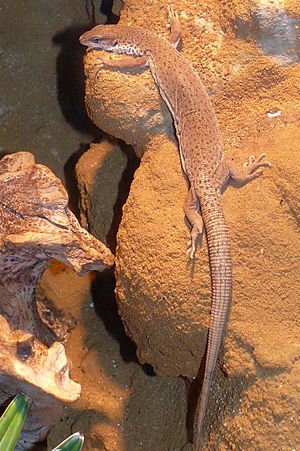Stripe-tailed goanna facts for kids
Quick facts for kids Stripe-tailed goanna |
|
|---|---|
 |
|
| Conservation status | |
| Scientific classification | |
| Genus: |
Varanus
|
| Species: |
caudolineatus
|
The stripe-tailed goanna (Varanus caudolineatus) is a cool lizard from Western Australia. People also call it the line-tailed pygmy monitor. It's a type of monitor lizard that likes to live in trees.
Contents
What Does It Look Like?
These goannas can grow up to about 32 centimeters (12.6 inches) long. That's about the length of a school ruler! They become adults when they are around 9.1 centimeters (3.6 inches) long from their snout to the start of their tail.
It's hard to tell male and female stripe-tailed goannas apart. They look very similar. Sometimes, people confuse them with the pygmy mulga monitor. This is especially true for stripe-tailed goannas that live in the northern parts of Australia, as they tend to be bigger.
Where Do They Live?
You can find stripe-tailed goannas only in Western Australia. This helps tell them apart from pygmy mulga monitors, which live in central Australia. Even though their known homes don't overlap now, scientists are always looking for more information.
These goannas love different kinds of places. They live in grasslands, woodlands, and shrublands. They especially like areas with acacia trees and spinifex grass. You might find them hiding under loose tree bark. They also like hollows in mulga and eucalyptus trees. Sometimes, they hide in rock cracks too.
What Do They Eat?
The stripe-tailed goanna eats small bugs and other tiny creatures. Their favorite snacks include roaches, grasshoppers, spiders, and scorpions. Sometimes, they also eat centipedes, beetles, cicadas, and moths.
They also like to eat smaller lizards, especially geckos. Some geckos they hunt are Gehyra punctata, Gehyra variegata, and Rhynchoedura ornata. If a gecko is too big to eat whole, the goanna might still attack it. They do this to get the gecko's tail, which can break off easily. Even though they live in trees, they often find their food by looking on the ground. They might even go into burrows to find prey.
Daily Life and Behavior
Stripe-tailed goannas don't move around a lot. They are most active when it's super hot, usually between 30-45 degrees Celsius (86-113 degrees Fahrenheit). Even then, they don't travel far. They usually stay within 34 meters (about 111 feet) of their tree.
They often stay in the same tree for about three days. Sometimes, they might not leave a tree for up to 15 days!
These goannas can be quite friendly with each other. You might find up to four of them living close together in a small area. Males and females seem to get along well.
Reproduction and Life Cycle
Stripe-tailed goannas likely mate in July and August. After mating, the female goanna lays a clutch of 4 to 5 eggs. This usually happens between November and December.
Who Hunts Them?
Birds that hunt, like eagles, sometimes prey on stripe-tailed goannas. Snakes also hunt them. Bigger monitor lizards, such as Gould's monitors, can also be predators.
See also
 In Spanish: Varano de Cola Rayada Australiano para niños
In Spanish: Varano de Cola Rayada Australiano para niños


